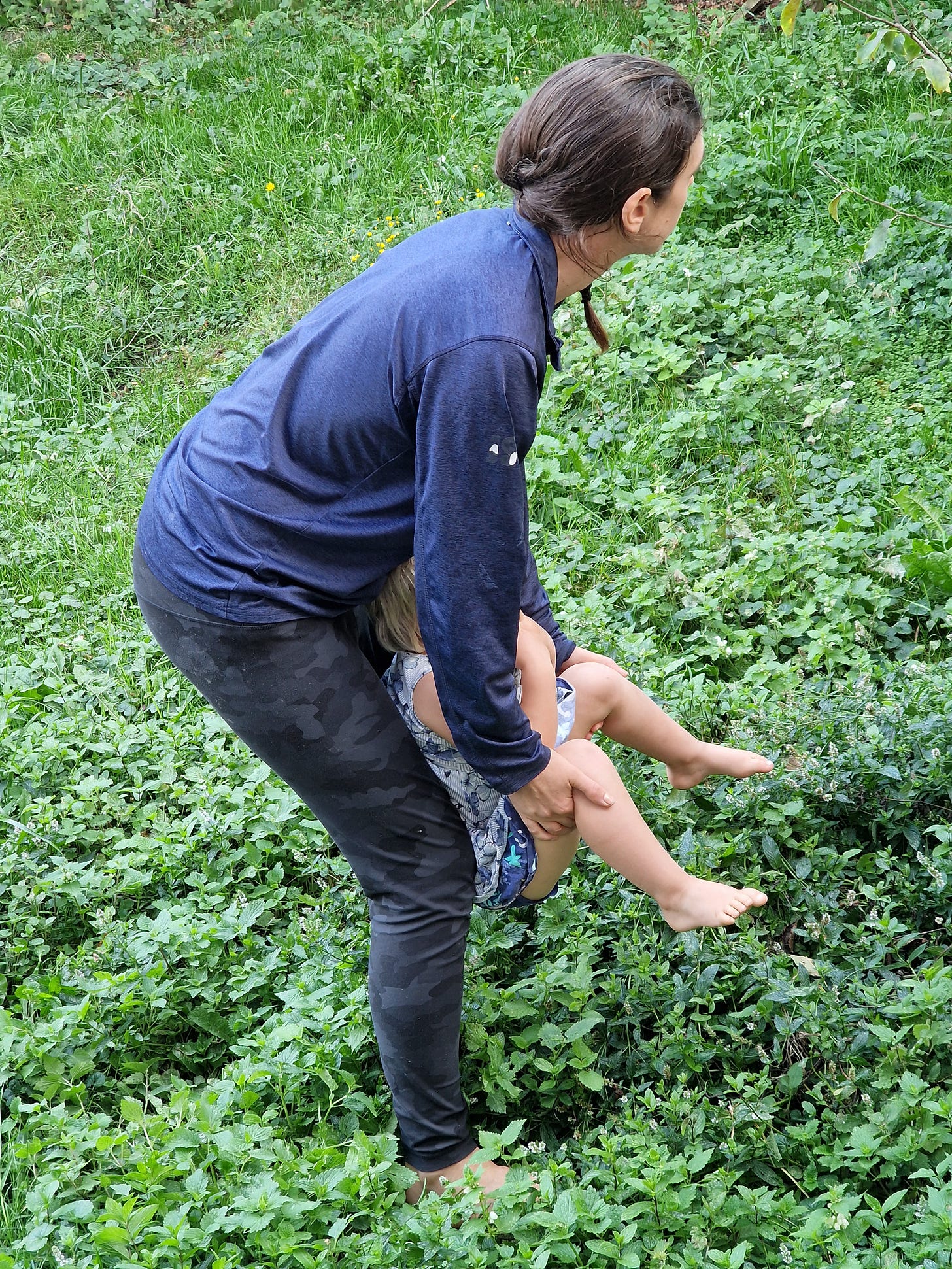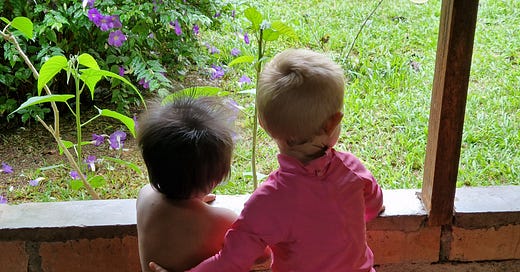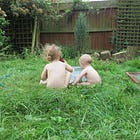What could you do to prevent your baby’s poo ever touching their skin?
It was Mothers’ Day in Southern Guyana. The rain was coming down so hard that the surface of the puddles was being pounded into fragments and mist. The river had risen half a metre in the last 24 hours and would continue rising for weeks.
All of the village mothers, myself included, had been given fried fish, cassava farine and a warm blessing (possibly curse?) of “Happy Mothers’ Day! May you have many more children!”. I was standing out of the rain, eating my fish, chatting to one of the village elders.
“When was that!?” I yelled over the roaring of the rain on the thin iron roof. I could barely hear myself shouting. My heart was pounding because, despite my brain’s reassurances, my body wouldn’t believe that there wasn’t a train passing inches above my head.
“Ten years ago!” Trevor shouted back, leaning closer. “Before that, there were no nappies in the village. Before that, we just took the babies outside when they needed to relieve themselves. The babies are cleaner that way. They don’t get wounds. They have dignity.”
He was right about the wounds. Nappy rash (or ‘diaper dermatitis’) affects almost every nappy-wearing child at some point, and a recent study (see below) found that half of nappy-wearing children visiting a hospital (for other reasons) had nappy rash when examined. Half.
Many of us reading have seen the red, oozing sores of nappy rash, but what actually is it? It’s all about broken barriers:
Every outside surface of the body has a barrier to protect the underlying tissue. The barriers may be very different (some parts, like the soles of the feet, have multiple millimetres of constantly-renewing flat plates of keratin (the same incredibly tough protein that rhinos make their horns out of) all bound together with waterproof ceramide wax and various antimicrobial ingredients. Some parts, like the front of the eye, have a very thin layer of antimicrobial proteins dissolved in water with one ten-millionth of a metre of oil on top to stop the whole thing evaporating), but they are always there.
And, regardless of structure, all body barriers are trying to do the same things:
keep in water, salt, and proteins;
keep out microbes, toxic chemicals, and physical damage (like sun radiation or abrasion);
and try not to get in the way of that surface's function in the process.
The skin barrier’s job is very simple (keep everything out/in while still being bendy), but the working conditions are very difficult (too dry to employ living cells, continual assault from the environment). To solve this, us mammals use a skin barrier made of keratin-filled dead cells, glued together with oil and wax. At the surface, special glands release sebum, which is part probiotic, part antimicrobial and part solvent. The sebum not only improves the skin microbiome, but also dissolves some of the wax that holds the dead keratin cells together, allowing them to flake off and carry any clinging pathogens or parasites away with them. As long as the rates of cell loss and cell replacement stay the same, then it's a beautifully effective, robust system.
This beautifully effective, robust system can resist most of the challenges that we humans have encountered during our time on Planet Earth. Which is fortunate - as well as letting our valuable fluids leak out, a damaged skin barrier allows outside substances to go in.
There are some things outside (e.g. pathogenic bacteria) that can hurt us if they get inside. Accordingly, if these things show up inside, the body immediately gets pretty upset and tries to fight them. We harness this exact process, the innate immune response, to make vaccines. We mix some bits of dead microbes (which enrage the immune system) and some bits of a target pathogen (the thing we want the body to learn to attack) and we inject the mixture to bypass the skin barrier. The body misattributes its irritation to the target pathogen and learns to attack it, providing us with immunity in the process. Great.
Unfortunately, this immunological bait-and-switch can happen by accident. If there are holes in our body barriers, bits of dead microbes and bits of environmental substances (e.g., pollen, cat dander, etc.) get in, the immune system gets tricked into misattributing damage to the environmental substances. Bingo: We have an allergy.
So, anything that damages the skin barrier increases the risk of allergy development. But nappies are especially good at it. Why?
Firstly, they are waterproof and so trap the moisture that comes off the skin - so even if the baby is not ‘wet’, their skin is still much wetter than well-ventilated (i.e. naked) skin would be. When skin is kept wet, the keratin plates start to swell and eventually don't fit together properly. Think of how soft and soggy skin gets under a plaster. Wet skin is both stickier and weaker than dry skin, so any rubbing or friction causes damage. This alone would cause skin damage under nappies, but things are about to get worse.
Urine has a much higher pH than skin, so when the skin is covered in urine, the pH is wrong, which makes the skin feel itchy and causes more harmful bacteria to grow. If things get messy, the bile acids in baby poo act as a detergent, dissolving the waxy ‘glue’ between the skin cells. And, to top it off, the high pH of urine then reactivates the protein- and fat-digesting enzymes, so they start digesting the skin itself. It's hard to think of a better way of damaging the skin barrier!
And that damage hurts! Nappy rash is painful and distressing for the baby. It increases the risk of skin infections, any of which can progress to deep tissue infections or abscesses. Either of those could require antibiotic treatment, which would decimate the microbiome, which (at that age) would spell long-term damage to health. Beyond that, with growing antibiotic resistance, resistant infections from nappy rash are an increasing concern themselves. But the consequences of nappy rash go beyond infections.
Nappy rash is a breakdown of the skin barrier and allows antigens (bits of other organisms that the body can react to) access to the tissues. We know this because babies become allergic to the dyes in nappies and other nappy products. Nappy rash can be caused by food allergy, but given what we now know about skin barriers, nappy rash may well allow food antigens (from faeces) to cross the skin barrier and enter into the body causing the food allergies in the first place.
To prevent nappy rash, nappy companies often advise parents to use moisturising creams before the child has skin irritation. We should be very careful when following this advice. It feels intuitive - right? Moisturisers are greasy, they make the skin feel softer and nicer, so people assumed they’d be good for barriers. Turns out not. Using moisturisers seems to increase the risk of allergy development.
So, if nappies damage the skin barrier, and using moisturisers worsens the risk of allergies developing, then what’s to do?
Give babies lots of time without a nappy. Drying the skin out is really important. Bare-bottomed baby playing on a towel works well.
Don’t use moisturisers on babies. (I know, I know, everyone loves a greasy baby).
Try not to let babies poo in nappies. Take the nappy off when you think the baby needs a poo. Hold them in a squat position over a potty, sink or bowl and let them empty themselves there (which they will often do, thanks to a nifty reflex), this prevents them from spending time with poo touching their skin and makes clean-up about a thousand times easier. Additionally, the squat posture helps them fully empty their bowel, which means longer until they next need to go. Read up on ‘elimination communication’ for more information.
Babies who were given antibiotics at or around birth are at especially high risk of allergy because of the disruption to the baby’s normal microbial colonisation. Protecting their skin barriers is especially important.

It’s possible to have a healthy skin barrier even when it’s often covered by a diaper, but it’s not easy. The convenience of diapers is offset by the difficulty of keeping a baby comfortable and healthy. Like with everything, the solution comes from finding a middle ground.
Diapers are useful when they are needed, but we need to take advantage of the times when they aren’t.
Want to hear my partner and I discuss our work on preventing allergies in children? We have a podcast where we use the topic from the previous post and give context and examples to help bring it to life. There’s also a weekly news section where we dive into interesting research into child development from the previous week.
This is the sound of Sunday evenings in our house!
You may also like:
Or maybe you prefer a podcast?
Notes
Overview of the damaged-barrier hypothesis for allergy development: Yazici, Duygu, et al. "Epithelial barrier hypothesis and the development of allergic and autoimmune diseases." Allergo Journal International 31.4 (2022): 91-102.
Nappy rash is scarily common: Incidence and Risk Factors of Diaper Dermatitis in Hospitalised Children Aged 0-24 Months: An Epidemiological Descriptive Study in Iran.
Nappy rash can lead to nasty resistant infections: Bender, Jeffrey M., and Rosemary C. She. "Elimination communication: diaper-free in America." Pediatrics 140.1 (2017).
Children become allergic to nappies and other products for cleaning the genital area; Alberta, Lauren, Susan M. Sweeney, and Karen Wiss. "Diaper dye dermatitis." Pediatrics 116.3 (2005): e450-e452. and Yu, JiaDe, et al. "Potential allergens in disposable diaper wipes, topical diaper preparations, and disposable diapers: under-recognized etiology of pediatric perineal dermatitis." Dermatitis 27.3 (2016): 110-118.
Celiksoy, Mehmet Halil, et al. "Characteristics of persistent diaper dermatitis in children with food allergy." Pediatric dermatology 36.5 (2019): 602-606.
Nappy rash can be caused by food allergy: https://onlinelibrary.wiley.com/doi/full/10.1111/pde.13495
Parents are advised to use moisturisers to prevent nappy rash: Blume‐Peytavi, Ulrike, and Varvara Kanti. "Prevention and treatment of diaper dermatitis." Pediatric dermatology 35 (2018): s19-s23.
But moisturisers increase the risk of children developing food allergies: Perkin, Michael R., et al. "Association of frequent moisturizer use in early infancy with the development of food allergy." Journal of Allergy and Clinical Immunology 147.3 (2021): 967-976.











It was obvious to me that prompt attention to diapers and twenty minutes of bare bum time after cleaning up made my babies happier all day long. Goodness, it made the whole family happier!
But, this allergy link. Tell me more, y'all. What have your experiences been?
Thank you for this article! It's such great information.
I when you say that the pH of urine is higher than the pH of the skin, do you mean urine is more alkaline than the skin?